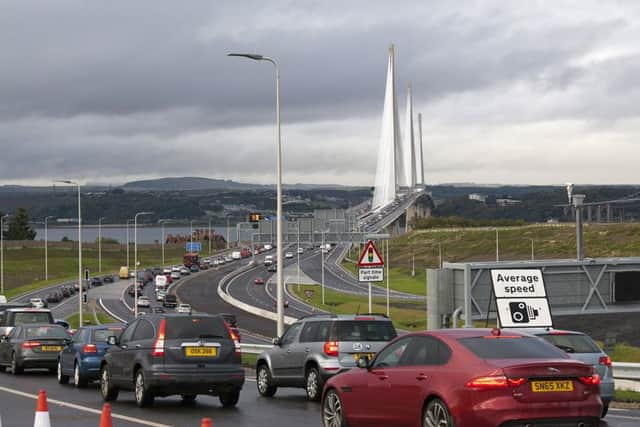Call to ease tailbacks misery on Queensferry Crossing
and live on Freeview channel 276
Experts called for more flexibility as the £1.35 billion bridge turns a year old today, with at least another month of roadworks expected.
Drivers crossing between Edinburgh and Fife have routinely been caught up in delays during overnight restrictions to complete unfinished and snagging work.


Advertisement
Hide AdAdvertisement
Hide AdHowever, The Scotsman understands there has been less flexibility over the lane closures than on other main roads and on the Forth Road Bridge in the past.
Drivers have reported preparations for the closures regularly starting at 7pm, with lanes often shut from 8pm.
This has led to “considerable” tailbacks and doubled journey times.
The Scottish Government’s Transport Scotland agency said the work would have a “minimal impact” on traffic.
Advertisement
Hide AdAdvertisement
Hide AdThere have been claims the Forth Crossing Bridge Constructors (FCBC) group wants to ensure the work is finished by the end of next month, as ministers have pledged.
One source said: “I am pretty sure there will be times they go for it just because all the lads and equipment are ready.”
IAM RoadSmart said the start of work should be put back when traffic was heavy.
Scotland-based policy and research director Neil Greig said: “Congestion on the crossing causes delays, frustration and unnecessary pollution as well as continuing to undermine the image of the project as a whole.
Advertisement
Hide AdAdvertisement
Hide Ad“Drivers are Transport Scotland’s customers and minimising their inconvenience must come before the short-term needs of contractors. Maximum flexibility should be the key.”
A Transport Scotland spokesman said: “The installation of traffic management is treated consistently across the trunk road network, taking into account traffic volumes and incidents.
“The Queensferry Crossing contractor has staff available to install traffic management from 8pm each evening, but such measures are only adopted once traffic is free flowing and congestion has eased.
“Traffic can start to build at other times, and if that occurs it is not possible to safely remove traffic management again without causing additional congestion.”
Advertisement
Hide AdAdvertisement
Hide AdMeanwhile, Transport Scotland said the wind shields and hard shoulders on the new bridge helped reduce the impact of high winds, accidents and breakdowns in contrast to the long delays experienced in the past on the Forth Road Bridge.
Since the new bridge opened, there have been 14 occasions when the Forth Road Bridge would have had to close to high-sided vehicles, Transport Scotland said.
On the Queensferry Crossing it typically takes around one hour to restore normal traffic conditions following an incident, compared with one to five hours on the Forth Road Bridge.
Transport Secretary Michael Matheson said: “The recent Audit Scotland report recognised the Queensferry Crossing as having delivered its objective of providing a more reliable road link between the Lothians and Fife.
“One year on since opening the new bridge, we are today providing further evidence that shows how reliability of journeys over the Forth have improved in the last twelve months.”
